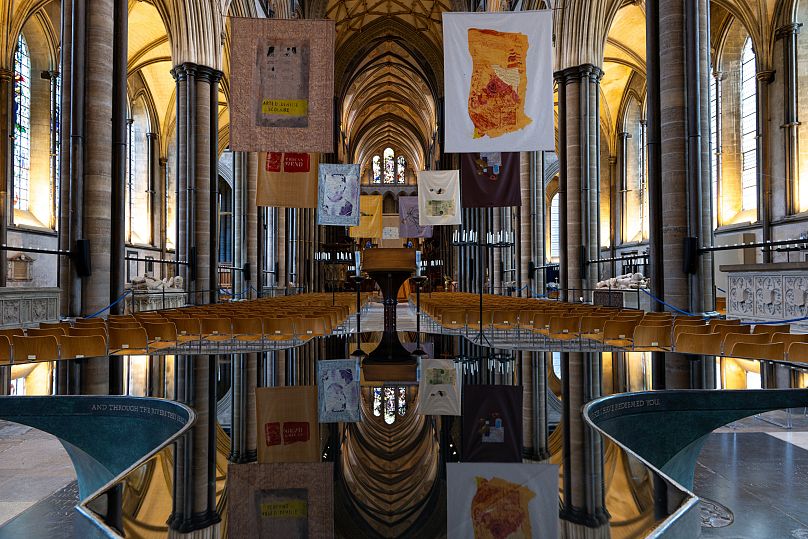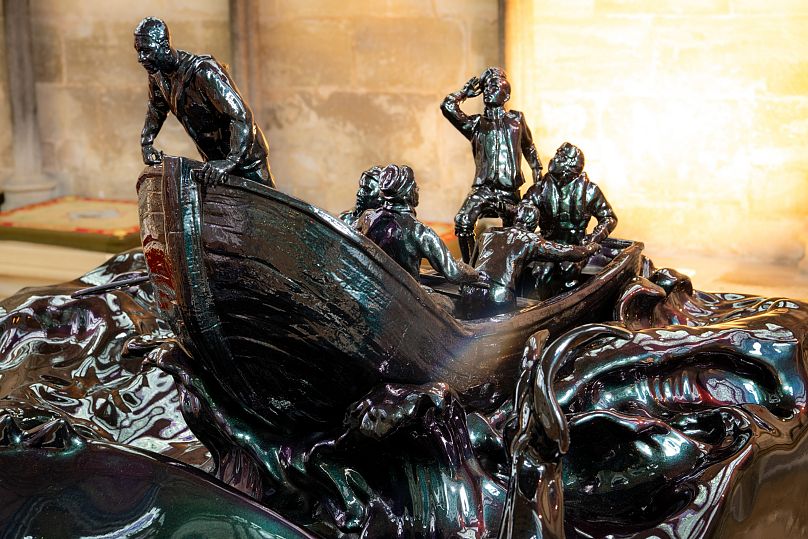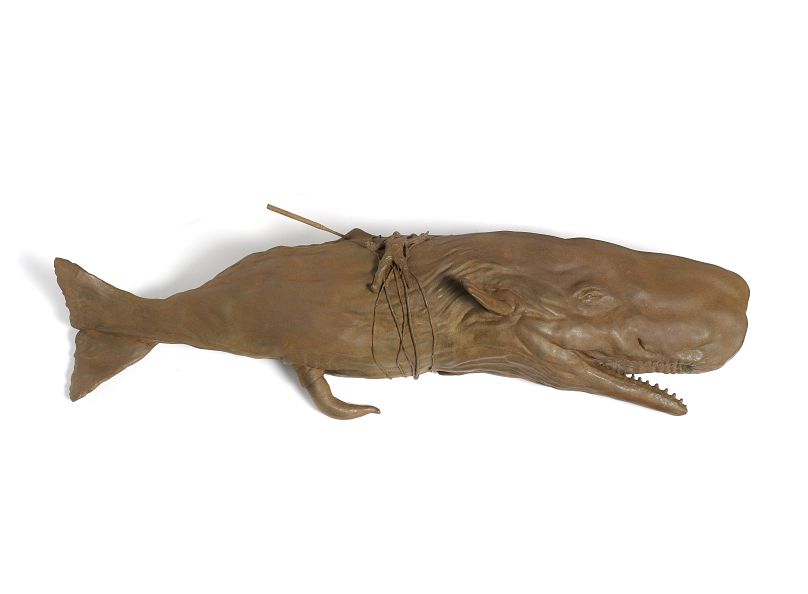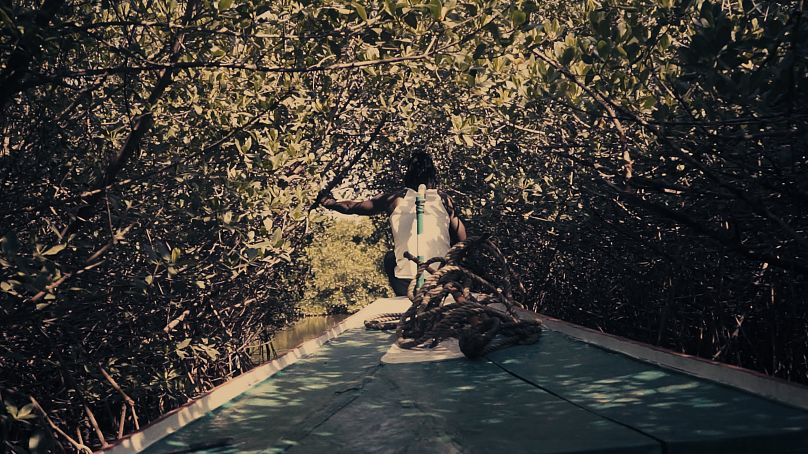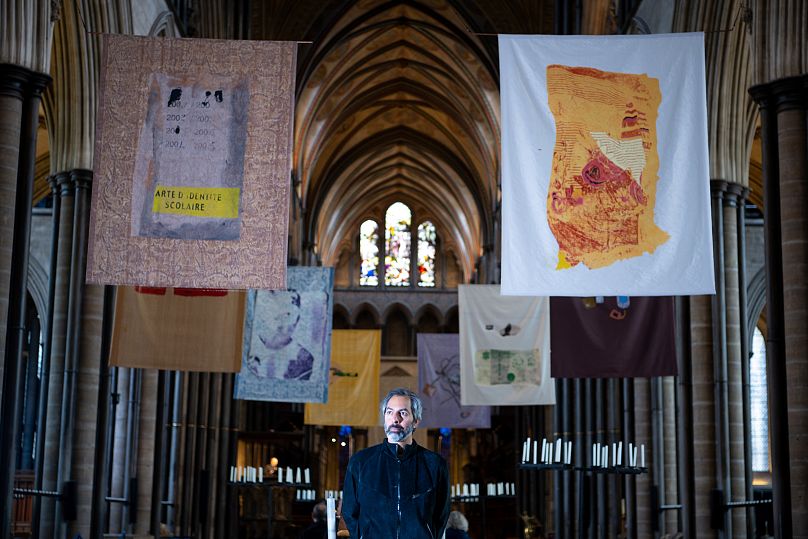Conceived in collaboration with climate scientists, marine biologists and oceanographers, Shezad Dawood's works explores what binds us with the world and the need for radical empathy towards our fellow humans.
A school ID card. USB sticks. Cigarettes. Small packets of soil, tokens of a homeland left behind.
These are among the objects hanging – in the form of textile paintings – high in the nave of Salisbury Cathedral.
Titled the Labanof Cycle, they belong to British-Pakistani artist Shezad Dawood’s pertinent Leviathan exhibition, which invites visitors to reflect on migration and climate change amid the cathedral’s Early English Gothic architecture.
The origins of the objects are far removed from the calm of such a sacred space: each is a personal effect of a refugee or migrant who lost their life while attempting the perilous journey between North Africa and Italy, collected and archived by the Labanof (Laboratory of Anthropology and Forensic Odontology) at the University of Milan.
As well as helping “bring closure to the families of refugees and migrants”, Dawood explained, Labanof collects the items as “forensic evidence against nation states, who were maybe purposefully turning a blind eye to a refugee boat in distress”.
Particularly in an era in which he sees formerly relatively isolated incidents “ramped up as populist government policy”, the London-based artist has enlisted the ill-fated objects with an additional purpose in mind: fostering empathy.
Inside objects, inside minds
“Each forensic tray is a human life, and seeing them brought it home that these are individual human lives with dreams, hopes, hobbies, ambitions and loves,” the London-based artist told Euronews Culture. “If the objects could do that to me, to bring them to a broader public could perhaps influence the debate and how we view them – as literally other human beings, not ‘invaders’ or other ways in which they’re demonised.”
In addition to the Labanof Cycle, Leviathan includes works such as Where do we go now?, a resin sculpture based on Jonathan Swift’s 1704 satire A Tale of a Tub.
In Dawood’s rendering of the tale, however, some the 18th-century sailors are replaced by a refugee and a UN aid worker. Most poignantly, the sculpture – whose polychromatic paint gives the work an ever-changing hue depending on light conditions – is placed within Salisbury Cathedral’s Chapter House, home to a well-preserved original of the Magna Carta. For Dawood, its placement in the Chapter House, crucially, places the work “in dialogue” with “an evolving notion of human rights over time”.
Climate-inspired creations
A motif linking much of Dawood’s recent work – for instance his Coral Alchemy (Acropora Grove) sculpture, reflecting on human impact on coral reef systems, concurrently on show at Manar in Abu Dhabi – is climate change. Leviathan continues this thematic thread with AnthropoPangaea (Hapalochlaena lunulata), a textile work in the cathedral’s north transept that takes viewers back to the time of a single supercontinent and superocean, together with a small whale sculpture (also titled Leviathan) referencing Herman Melville's Moby Dick to convey tension between man and nature.
Cathedral visitors can also sit down in front of the two most recent episodes of the artist’s ongoing Leviathan film cycle, one taking the viewer through the Mangroves of Senegal, and the other the Atlantic Forest in Brazil.
Realised in collaboration with climate scientists, marine biologists and oceanographers, the works explore the interconnectedness of our world – and the need for radical empathy not only towards our fellow humans, but to the planet itself.
“My mission has been to see how we provoke greater empathy for other humans but also for the non-human world,” said Dawood. “Not as a binary separated from us, but something we’re intimately interconnected with and part of.”
The artist sees “breaking down the artificial divide between nature and culture,” by way of increased empathy, as nothing less than a “question of survival”. “If we just eradicate all marine life and the oceans become lifeless, we’re all going to die because it is – we are – one system, whether we like to consider it like that or not,” he explained.
What is striking, throughout Leviathan, is the note of optimism palpable. This is evident not least in the video works, which are set in a near-future world and tap into traditional knowledge and stories to consider strategies for survival – encapsulated perhaps most aptly in the closing line of the latest episode: “And in the end, the darkness didn’t scare me anymore.”
This optimism is undoubtedly born, too, of the show’s cathedral context.
The Revd Dr Kenneth Padley, chair of the cathedral’s arts advisory panel and its Canon Treasurer, sees the cathedral as an apt location for the show – and particularly in the run-up to Christmas.
“For us, the work that Shezad is doing around migration and climate change are illustrations of the messiness of the world into which Jesus was born, that’s the truth at the heart of Christmas,” he told Euronews Culture. “In particular relation to migration, there is that part of the Christmas story where Jesus himself is an emigrant where he flees from the evil King Herod.”
In addition to well-attended Advent and Christmas services, Dawood’s works commune and converse with the daily rhythms of the cathedral as a place of worship.
“Every hour on the hour we have a two minute prayer… it can feel like an answer to a question being posed in the artworks,” suggested Beth Hughes, the cathedral’s visual arts curator.
Leviathan runs at Salisbury Cathedral until February 4 2024. The exhibition is free with cathedral admission.












